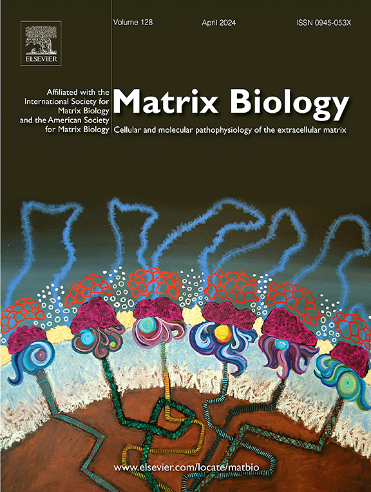ECM蛋白在果蝇翅盘基底膜中形成地形模式
IF 4.8
1区 生物学
Q1 BIOCHEMISTRY & MOLECULAR BIOLOGY
引用次数: 0
摘要
上皮组织的基底表面附着着一层称为基底膜的大分子薄网络。基底膜的核心成分-胶原IV,层粘连蛋白,Perlecan和Nidogen -是跨物种保守的细胞外基质(ECM)蛋白。然而,基底膜的地形和单个核心成分对其建立的贡献仍然知之甚少。在此,我们使用afm辅助PeakForce攻丝对果蝇幼虫翅盘基底膜的形貌进行了分析。我们确定了一个自仿射表面形貌,在多个尺度上出现结构相似。此外,地形的特征是薄的纤维状结构,沿着前后轴间歇性地以首选方向排列。在幼虫发育过程中,表面图案的幅度总体下降,而基底膜成分的丰度增加。通过靶向敲除实验,我们发现胶原蛋白IV对于纤维样结构的形成至关重要,而层粘连蛋白和胶原蛋白IV似乎可以平滑或平整大规模的沟槽样结构。相比之下,氮气有助于维持这些凹槽,而Perlecan则增加了所有长度尺度上的表面图案振幅。我们的发现揭示了基底膜的独特地形特征,其振幅和组织取决于其特定的分子组成。本文章由计算机程序翻译,如有差异,请以英文原文为准。
ECM proteins shape topographical patterns in the basement membrane of Drosophila wing discs
The basal surface of epithelial tissues is attached to a thin network of macromolecules known as the basement membrane. The core components of the basement membrane — Collagen IV, Laminin, Perlecan, and Nidogen — are conserved extracellular matrix (ECM) proteins across species. However, the topography of basement membranes and the contribution of individual core components to its establishment remain poorly understood. Here, we used AFM-aided PeakForce tapping to analyze the topography of the basement membrane of Drosophila larval wing discs. We identified a self-affine surface topography, appearing structurally similar across multiple scales. Further, the topography is characterized by thin fiber-like structures that are intermittently aligned with a preferred orientation along the anterior-posterior axis. During larval development, the amplitude of surface patterns overall decreases, whereas the abundance of basement membrane components increases. Using targeted knockdown experiments, we show that Collagen IV is essential for the formation of fiber-like structures, while Laminin and Collagen IV appear to smooth or level out large-scale groove-like patterns. In contrast, Nidogen contributes to the maintenance of these grooves, and Perlecan increases surface pattern amplitudes at all length scales. Our findings reveal distinct topographical features in the basement membrane, whose amplitude and organization depend on its specific molecular composition.
求助全文
通过发布文献求助,成功后即可免费获取论文全文。
去求助
来源期刊

Matrix Biology
生物-生化与分子生物学
CiteScore
11.40
自引率
4.30%
发文量
77
审稿时长
45 days
期刊介绍:
Matrix Biology (established in 1980 as Collagen and Related Research) is a cutting-edge journal that is devoted to publishing the latest results in matrix biology research. We welcome articles that reside at the nexus of understanding the cellular and molecular pathophysiology of the extracellular matrix. Matrix Biology focusses on solving elusive questions, opening new avenues of thought and discovery, and challenging longstanding biological paradigms.
 求助内容:
求助内容: 应助结果提醒方式:
应助结果提醒方式:


